Uzbekistan is a bright, inspired country of the East. It is simply impossible to count all the mosques, madrasahs, mausoleums and minarets of the country. It is also impossible to convey their beauty. This must be seen.
Many roads of the Great Silk Road passed through Uzbekistan. Uzbek cities grew up on this road of wealth and contact of cultures. Tashkent, Samarkand, Bukhara, Khiva are dotted with magical architecture, they will captivate everyone who sees them at least once in their life.
You can endlessly describe the shrines and citadels of Uzbekistan, but besides this, it is rich in nature. Many tourists pass through the hot Kyzylkum desert and then go to the picturesque Ferghana Valley or the Chimgan Mountains. There are all conditions for recreation.
Uzbekistan is an ideal country for a budget tourist, which does not skimp on sights at all and will give inexpressible impressions to anyone who wants to see its beauties or try the original Uzbek cuisine.
What to see in Uzbekistan?
The most interesting and beautiful places, photos and a brief description.
- City of Tashkent
- Samarkand city
- Registan Square in Samarkand
- City of Bukhara
- Khiva city
- Ichan-Kala fortress in Khiva
- Aral Sea
- Lyabi-Hauz in Bukhara
- Observatory Ulugbek
- Bibi-Khanum Mosque in Samarkand
- Monument of architecture Shakhi Zinda
- Ark Citadel
- Gur-Emir (Mausoleum of Tamerlane)
- Mausoleum Rukhabad in Samarkand
- Mausoleum of the Samanids (Bukhara)
- Minaret and mosque Kalyan in Bukhara
- Charvak reservoir
- Amir Temur Square
- Tashkent TV tower
- Desert Kyzylkum
- Ferghana Valley
- Chimgan mountains
- Oriental Bazaar Chorsu
- Ship cemetery in Muynak
City of Tashkent
This is the capital of Uzbekistan, it is one of the five largest cities in terms of population among the CIS countries. Ancient buildings, mosques, museums and madrasahs are hidden between modern buildings and skyscrapers. And colorful bazaars and markets where you can buy everything are surrounded by modern shopping centers. Tashkent is a very civilized and modern city, ideal for starting to explore the East.

Samarkand city
Samarkand was founded in the 8th century BC. This is one of the oldest cities on the planet. Samarkand has been a key point on the Great Silk Road for more than two thousand years. This is a precious pearl of Asia, a combination of two worlds - West and East. It was an important political, scientific and cultural center and has preserved a huge number of historical and cultural monuments. The entire city is listed as a UNESCO heritage site.
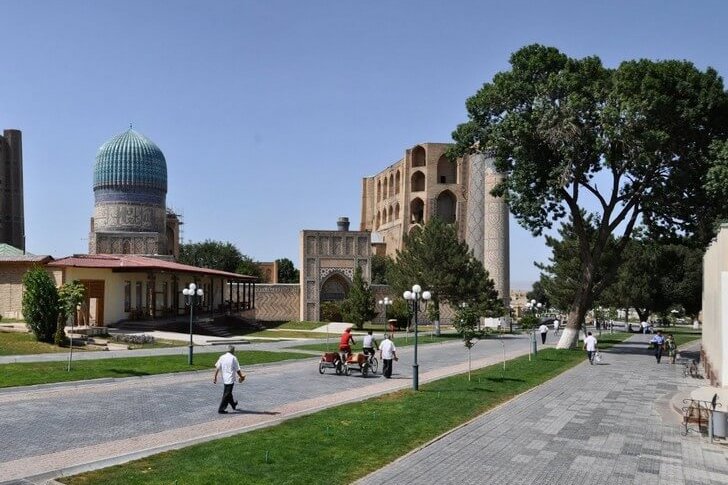
Registan Square in Samarkand
This is the heart of Samarkand. Once it was the center of city life, and after the construction of a beautiful architectural ensemble of the XV-XVII centuries, it became its pearl. Three madrasahs: Ulugbek, Shedror, Tilla-Kari surrounded the square. Their decor is varied, but they look great together. Today, various cultural events are held in the Registan, and tourists here begin to get acquainted with the city.

City of Bukhara
This is another city that grew up on the Great Silk Road, which has become a real treasure of the East. It was founded 2500 years ago and has developed rapidly since then. Bukhara is called a city-museum. The main exhibits here are citadels, mosques, madrasahs and mausoleums. Some of them are more than 1000 years old, and the Kalon Minaret is already about 2300 years old. The historical center of Bukhara is included in the UNESCO heritage list.
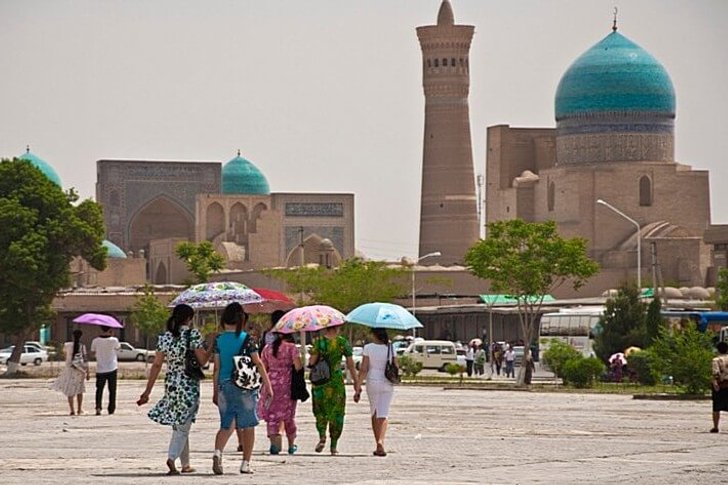
Khiva city
A small city, the capital of the Khorezm region, which, according to legend, grew up around a well dug by one of Noah's sons. Khiva has a huge number of amazing shrines and buildings. The old city - Ichan Kala - was the first object in Central Asia taken under the protection of UNESCO. During its thousand-year history, fortresses, palaces and mosques were built, which are now admired by tourists.
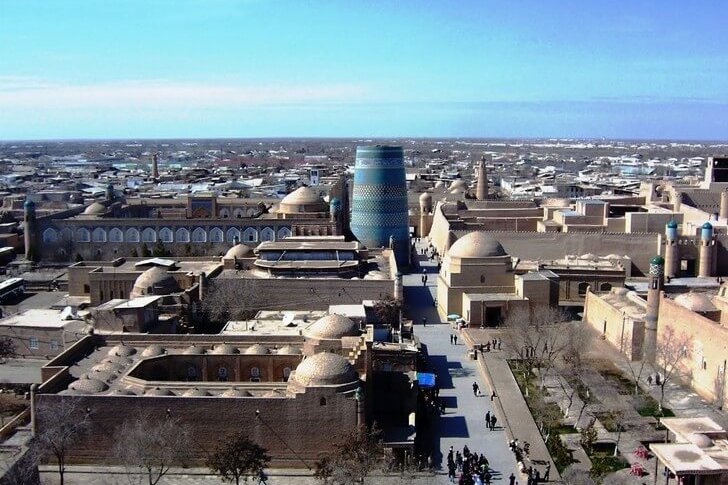
Ichan-Kala fortress in Khiva
This is the old city of Khiva, surrounded by a 2.5 km wall. Its height reaches 10 m, and its thickness is up to 6 m. Every 30 m, round defensive towers are erected in the wall. In a city of less than 1 km², an incredible number of attractions. Ichan-Kala is a typical eastern ancient city. It is dotted with a lace of narrow, small streets leading to grandiose structures.
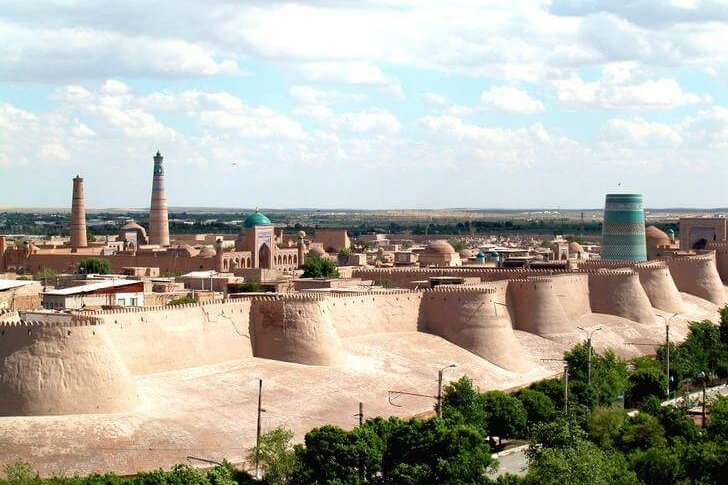
Aral Sea
This is a dying sea on the border of Uzbekistan and Kazakhstan. Once it had huge natural reserves, and was a very attractive place to live. Due to the withdrawal of water from the rivers, which were the main source of food for the lake, it began to dry up. Today it is divided into two parts: Southern (Big) and Northern (Small). Once upon a time, the Aral Sea was the fourth largest lake in the world.

Lyabi-Hauz in Bukhara
One of the squares of Bukhara, which was the center of trade, and now has become an object of admiration for tourists and locals. The first building on the square, which has survived to this day, was built in 1569. It was the Kukeldash Madrasah - the largest madrasah in Central Asia. Then Divan-Beri Madrasah and Divan-Begi khanaka appeared at Lyabi-Khauz.

Observatory Ulugbek
Ulugbek made a huge contribution to world astronomy, explaining the basics of this science and indicating the coordinates of more than 1000 stars. His observatory began to be built in 1424 on the Kuhak hill, and after 5 years it was equipped with a goniometer with a radius of 40.21 m. The building itself was three-story and had a height of 30.4 m. After the assassination of Ulugbek, the observatory was abandoned. It was only found in 1908.
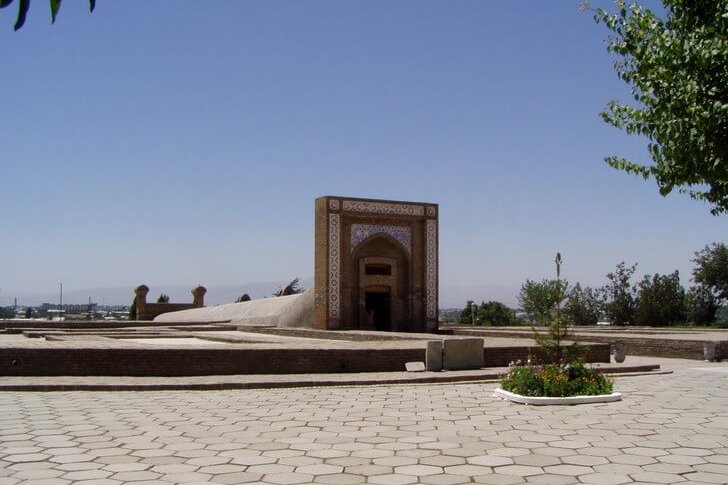
Bibi-Khanum Mosque in Samarkand
According to legend, Tamerlane, returning from a campaign with a victory, ordered the construction of a mosque in honor of his beloved wife. Construction began in 1399, after 5 years most of the work was completed. The best craftsmen from Khorezm, India, Iran, the Golden Horde worked on the creation of the mosque. The building, grandiose in beauty and size, could accommodate 10 thousand people at the same time. The Bibi-Khanum Mosque is the largest in Central Asia.
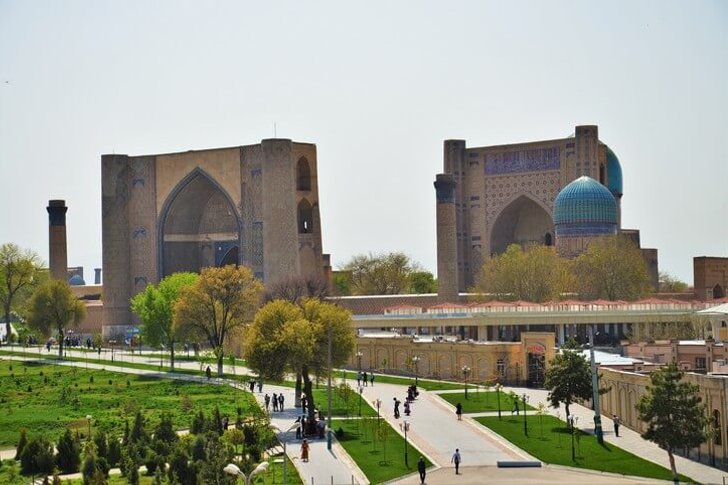
Monument of architecture Shakhi Zinda
This is a complex of 14 mausoleums in which the Samarkand elite is buried. It was created over 9 centuries, constantly being completed. The ensemble is also called the cemetery street. The blue domes of mosques and mausoleums, which stretch one after another, resemble an expensive necklace from above. The last building of the complex is the entrance to the crypt. To see the mausoleums, you need to climb 36 steps.

Ark Citadel
This is the oldest building in Bukhara, rising on a hill, which was manually built by slaves. One and a half thousand years ago, the ruler lived in it, and the foundation of the fortress was laid in the 4th-3rd centuries BC. e. The citadel was the residence not only of the ruler, but also of poets, scientists and philosophers. She survived many wars and absorbed the entire history of the East.

Gur-Emir (Mausoleum of Tamerlane)
Gur-Emir was built by order of Muhammad Sultan at the beginning of the 15th century. At first, the complex consisted of a madrasah, where children of the Samarkand nobility and khanaka were taught. But after the sudden death of his grandson, terribly grieving Amir Timur ordered the construction of a mausoleum, which was supposed to complement the Gur-Emir ensemble. Its interior decoration is rich and luxurious, and at the top of the building is a dome lined with blue mosaics.

Mausoleum Rukhabad in Samarkand
The mausoleum was built in 1380 by order of Amir Timur right above the grave of Burhannedin Sagaradzhi. He became famous for his huge contribution to the spread of Islam among the nomads. To express respect, the ruler erected the Rukhabad mausoleum. He is not pompous or rich. Everything is very strict and simple, without excessive gloss. Amir Timur himself, passing by the mausoleum, always dismounted from his horse and walked.
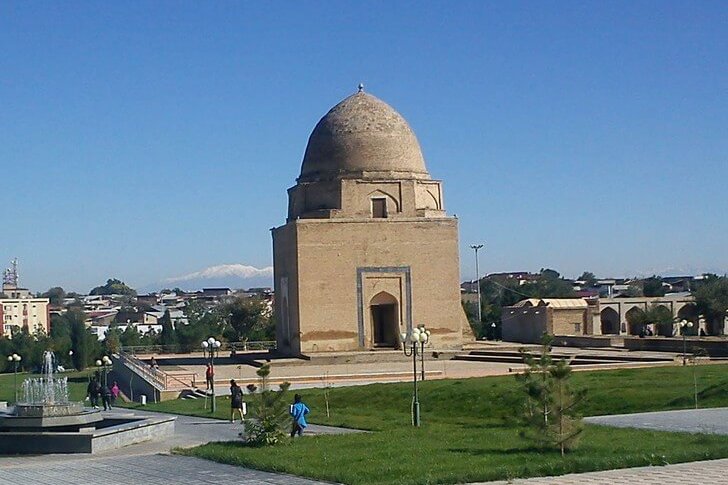
Mausoleum of the Samanids (Bukhara)
This is a bright representative of early medieval architecture. There are three graves in the mausoleum, one of them belongs to the son of Ismail Samani. The mausoleum was built in the 9th century. It has a symbolic shape of a cube with a dome, and its walls resemble an openwork ornament. All elements of decoration merge together and represent a unique example of Central Asian architecture.
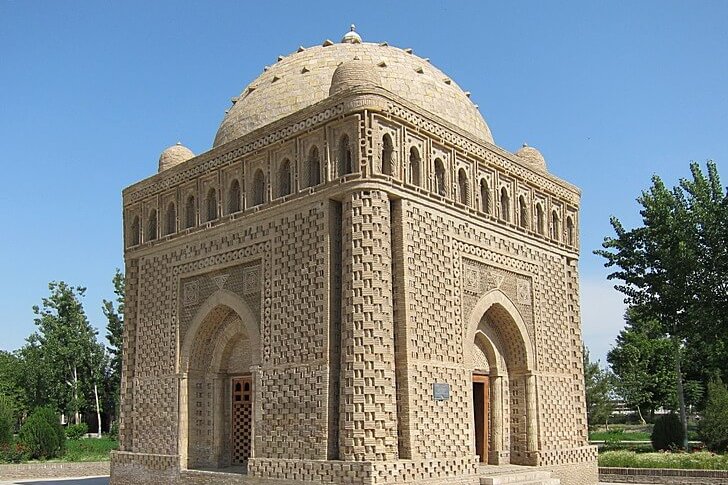
Minaret and mosque Kalyan in Bukhara
The minaret and the Kalyan mosque belong to the most beautiful architectural ensemble in the center of Bukhara. They are located on Registan Square. Kalyan Minaret is the oldest building on the square, it was built in 1127. During its existence, it was almost not repaired. The Kalyan Mosque is the second largest in Central Asia, its construction was completed in 1514. It is beautifully decorated with mosaics.

Charvak reservoir
After the earthquake in 1966, there was an urgent need for cheap energy. It was decided to build the Charvak GRES. The dam, 168 meters high, formed a blue, picturesque mountain lake. But its beautiful waters have hidden important archaeological sites. Once upon a time there were ancient settlements at the bottom of the lake. Scientists did research and photographed them, and now they have completely disappeared.

Amir Temur Square
Initially, the Square of Amir Temur under the name Konstantinovsky Square was founded by order of General Chernyaev in 1882. It was passable and was located at the intersection of two main streets of the city, which repeated the ancient trade routes. Subsequently, the park has changed many times. Only in 1994 it was renamed and a monument to Amir Temur was erected in it.

Tashkent TV tower
This is the second tallest building and the highest TV tower in Central Asia. Its height is 375 meters, it is visible from anywhere in the city. It was put into operation after 6 years of construction in 1985. There is an observation deck inside the TV tower, it is located at a height of 100 meters. A little higher, on two floors, there are restaurants. Their platform rotates around the tower. While eating, you can once again admire the views.

Desert Kyzylkum
This is one of the greatest deserts of Eurasia. Its area is 300 thousand km². Even in the shade, temperatures in it rise to 50 degrees, and the sand heats up to 70-80 degrees. The longest tourist route between Bukhara and Khiva passes through the Kyzylkum desert. Its length is 450 km. Some species of tulips and herbs grow in the desert, jackals, snakes and birds live.

Ferghana Valley
Among the mountains, almost completely surrounded by green peaks, lies the Ferghana Valley. Its territory is 22 thousand km², and together with the area of the Tan Shan mountains, it is almost 80 thousand km². The valley is fed by the waters of the Syr Darya and Naryn, it is an ideal place for animal husbandry and land science. On the territory of the valley there are several interesting cities, which tourists periodically visit.

Chimgan mountains
The mountains are located 80 km from Tashkent. The mountain range is relatively low, the average height of the mountains is 1500 meters, but it is considered one of the best places for winter holidays in Asia. There are many routes for skiers and hikers in the mountains. There are also conditions for mountain climbing. In summer, the meadows are amazingly beautiful, on which flowers grow. In the mountain villages they receive tourists and provide them with accommodation.
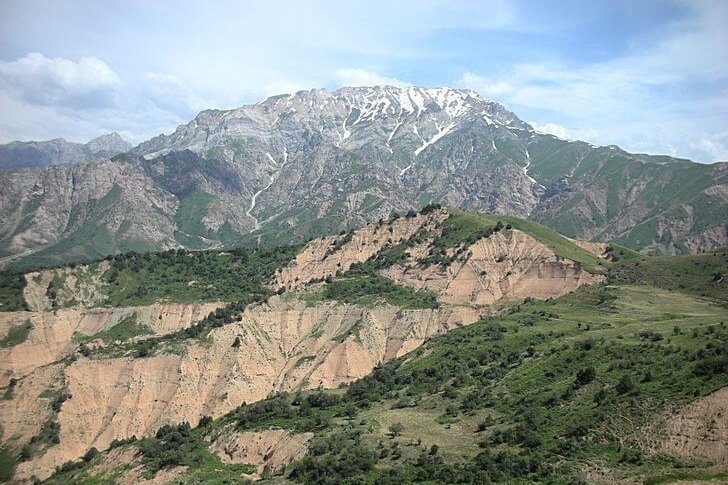
Oriental Bazaar Chorsu
Chorsu is located on Eski-Juva, the main square of Tashkent. This is an old colorful bazaar, which has been attracting traders of oriental sweets and spices for centuries. The bazaar is covered with an ornamented dome, which is designed to save from the heat. This bazaar is used for bargaining. A friendly attitude will help you bring down the price well and make excellent purchases.

Ship cemetery in Muynak
Once Muynak was one of the two main cargo and fishing ports of the Aral Sea. After the sea began to dry up, the fishery fell into disrepair. The city has been frozen in past decades, clutching at the remnants of the once-profitable water. The main attraction is the cemetery of no longer needed ships. Rusty, abandoned ships can be touched or even climbed on.
